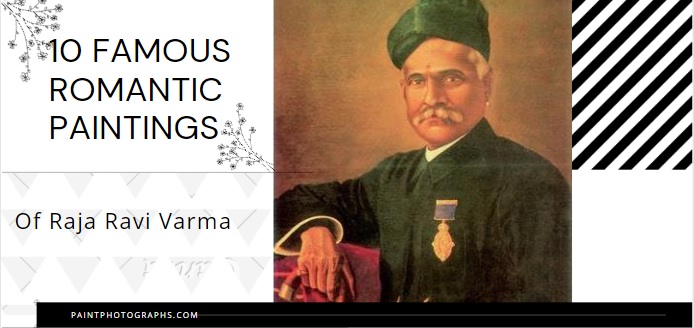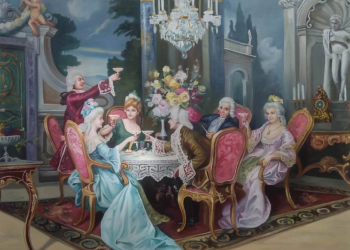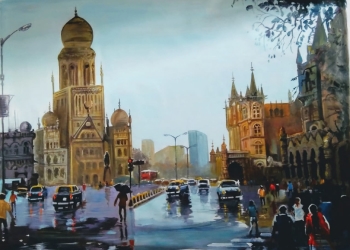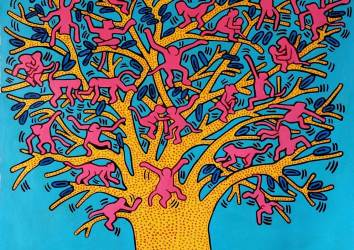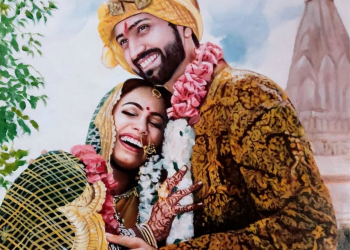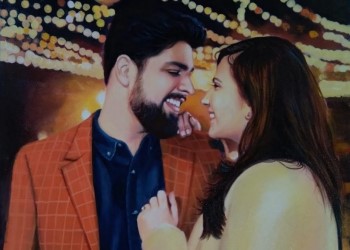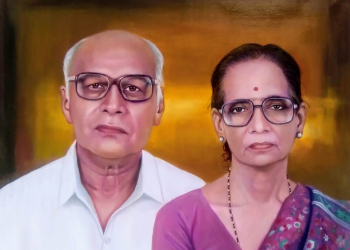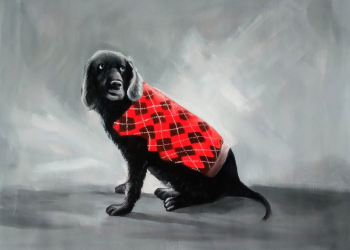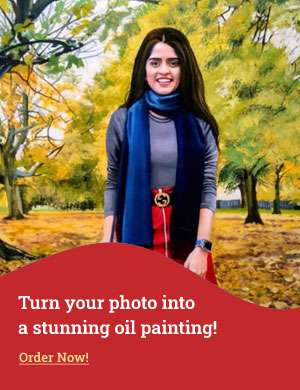Raja Ravi Varma was India’s greatest artist and painter. Famous for historical narrative paintings, portraits, and paintings of Hindu Gods. This post presents Raja Ravi Varma’s most famous romantic paintings
Introduction: Raja Ravi Varma Romantic Paintings
Raja Ravi Varma is perhaps India’s greatest painter and artist in the modern age. He single-handedly brought Indian art into the modern age by synthesizing European academic art with Indian sensibilities and Indian iconography.
Ravi Varma, Koil Thampuran was born in an aristocratic family in Kilimanoor palace, in the erstwhile princely state of Travancore. The title Raja was conferred on him much later by the British Viceroy and Governor-General of India as a personal title in the citation of the Kaiser-i-hind medal in 1904.
About his works, Rabindranath Tagore said,” In my childhood, when Ravi Varma’s age arrived in Bengal, reproductions of European paintings on the walls were promptly replaced with oleographs of his works.” According to art historian, Partha Mitter, “Ravi Varma’s history paintings epitomized the magic that was naturalism”
Like John Singer Sargent Ravi Varma was famous for his oil portrait paintings and unlike him, he was also famous for his narrative paintings of Indian history, mythology, and paintings of Gods, which he recreated from historical sources, like Hindu epics Ramayana, Mahabharata, and the Puranas.
In this essay, we will cover the romantic paintings of Raja Ravi Varma.
Handmade Art Reproductions & Landscape Paintings
Romantic paintings of Raja Ravi Varma
Before Raja Ravi Varma’s paintings, the paintings of Indian artists were greatly influenced by the Persian and the Mughal school. The paintings of that era, though delightful, lacked fluidity and appeared stiff. Many paintings also lacked depth and perspective. Raja Ravi Varma was one of the first Indian artists to marry European academic painting style with Indian sensibilities.
Known for his dramatic and theatrical compositions of his historical narrative paintings, Ravi Varma was to conceptualize and idealize the female figure, with many of the same guileful mannerisms, and romantic gestures of the Academic paintings of Europe. But clothed and ornamented in elaborate Indian dresses, and placed within a historical narrative painting as Shakuntala, Draupadi, or Damayanti
According to the author of The Painter: Raja Ravi Varma, Deepanjana Pal, “Ravi Varma adapted European realism and romanticism to Indian subjects, creating a style that felt simultaneously modern and traditional, both in its time and now. It is because the illusion he creates is one we want to imagine as real.”
Another innovation of Rai Varma was the realistic depiction of the moods and emotions of the subjects in his paintings. He became known for portraying romantic pathos in his paintings.
The romantic paintings of Raja Ravi Varma are particularly expressive of the emotions of love, longing, absence, and virah. While he created a great many portraits and historical paintings, the following paintings, are widely agreed among scholars and art aficionados as Ravi Varma’s best romantic painting work.
10. Shakuntala's Impending Calamity by Raja Ravi Varma
The story of Shakuntala and King Dushyanta has been a cherished part of Indian mythology and literature for centuries, with numerous adaptations and retellings in various forms of art and media. Raja Ravi Varma too was much inspired by the story and made a series of paintings based on the Shakuntala and King Dushyanta romantic love story. According to the entry in the diary of C. Raja Raja Varma, brother of Ravi Varma, dated 23rd February 1901, "Towards evening we went out of our hut (at Ghatkopar) to finish the open scenery in the picture of ‘Sakuntala’s Impending Calamity."
The completed painting was then exhibited at the Bombay Art Society Exhibition in March 1901, where it received much acclaim. Notably, the painting went on to win the 'His Highness the Late Martanda Varma, First Prince of Travancore Prize' for the best landscape in oils, with figures, by a native from India in a sum of Rs. 70.
In the Report on the Administration of the Government Museum and Connemara Public Library for the year 1901-1902, the oil painting on canvas was gifted to the museum, at which time it was referred to as "Sakuntala under the Shadow of an Impending Calamity."
The canvas oil painting Shakuntala's Impending Calamity by Raja Ravi Varma depicts the scene where Shakuntala is lost in thought of her lover Dushyanta. When Rishi (Sage) Durvasa visits the ashram where Shakuntala lived. One can see the sage at a distance behind the palmyra tree. Shakuntala sitting on a rock, under the tree is lost in her thoughts and fails to greet the great Rishi. The incensed Rishi Durvasa curses Shakuntala that her lover would lose all memory of her. He is thereafter implored to withdraw his curse. Durvasa relents and says the curse would be absolved when Dushyanta sees the ring given to Shakuntala by Dushyanta.
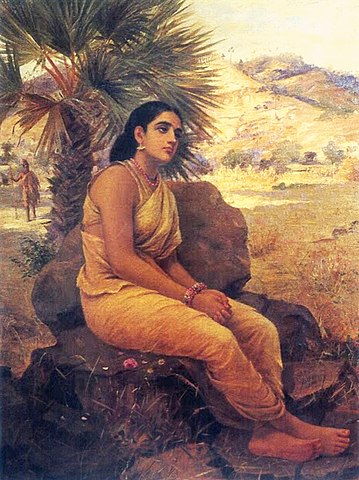 Shakuntalas impending calamity oil painting by Raja Ravi Varma (Image Credits: Wikicommon)
Shakuntalas impending calamity oil painting by Raja Ravi Varma (Image Credits: Wikicommon)
Title: Shakuntala's Impending Calamity
Creator: Raja Ravi Varma
Date Created: Late 1901
Physical Dimensions: 44.48 inches x 33.46 inches (113 cm x 85 cm)
Medium: Oil painting on canvas
Location: Collection of the Government Museum, Chennai, India
Order Your Portrait Painting from Photo today!
Painted in oil on canvas, the painting portrays Shakuntala seated on a rock under the palmyra tree, lost in thought with her gaze fixed at a distance. The use of color is particularly striking, with Raja Ravi Varma employing a muted palette of ochres, browns, and blues to create a sense of calm in the natural surroundings. The use of light and shadow adds depth and dimensionality to the painting, highlighting Shakuntala's sorrowful expression and the dry landscape. As though nature herself is sad at Shakuntala’s plight.
The composition of the painting is noteworthy, with Shakuntala's figure dominating the center of the canvas while the surrounding landscape serves to accentuate her isolation and despair. The simple yet tasteful details in her clothing and jewelry add a sense of refinement and elegance to the scene.
The title of the painting, Shakuntala's Impending Calamity, refers to the curse about to be placed upon Shakuntala by Rishi Durvasa, who is seen walking at a distance in the background.
Overall, Shakuntala's Impending Calamity is a powerful example of Raja Ravi Varma's ability to capture complex emotions and psychological states in his art. The painting's beauty, depth, and complexity make it a true masterpiece of Indian art, and a testament to Raja Ravi Varma's skill as an artist.
9. Untitled Damayanti by Raja Ravi Varma
Inspired by a composition taken from a photograph of a European performance of the play, L’inamorata (Feast of Roses), circa 1900, Ravi Varma reimagined the composition in the Indian context. Seeing Ravi Varma transform a European lady into his vision of idealized Indian beauty, complete with the transformation of her wardrobe from a costume to a saree, is fascinating.
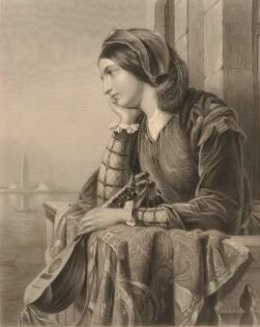 L’inamorata (Feast of Roses), circa 1900 (Image Credits: Britishmuseum.org)
L’inamorata (Feast of Roses), circa 1900 (Image Credits: Britishmuseum.org)
The tale of Nala and Damayanti appears in a story from the Indian epic Mahabharata. In the story, Damayanti and King Nala fall in love with each other after exchanging messages using a golden swan. The romantic setting of the canvas painting depicts this scene where Damayanti is lost in the thoughts of her lover Nala while being fanned by her attendant Keshini. Damayanti is in a glimmering white sari while her attendant is holding a fan and is wearing a blue sari. The gold jewelry and borders of both ladies' saris stand out while their bodies are poised yet dynamic. The white veranda floor is strewn with delicate flowers lending a sense of movement to the scene and contrasting with the gloomy skies above.
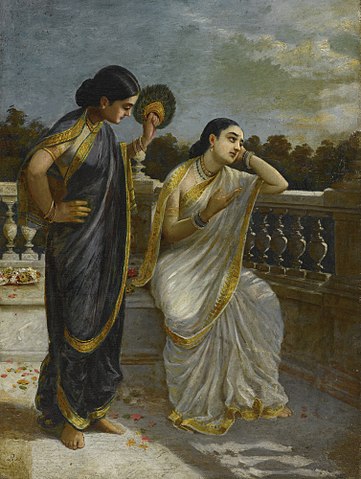 Untitled Damyanti, oil painting by Raja Ravi Varma, (Image Credits: commons.wikimedia.org)
Untitled Damyanti, oil painting by Raja Ravi Varma, (Image Credits: commons.wikimedia.org)
Title: Untitled (Damayanti)
Creator: Raja Ravi Varma
Date Created: Late 1890
Physical Dimensions: 28.74 inches x 20.74 inches (73 cm x 52.7 cm)
Medium: Oil painting on canvas
Location: Private Collection
It is evident that Ravi Varma loved the Damayanti and Nala story as he created many paintings from the Nala and Damayanti story in a variety of scenes and compositions.
8. Arjuna and Subhadra by Raja Ravi Varma
Arjuna, one of the greatest warriors of the Pandava clan, was in a difficult situation. He had violated the terms of his agreement with his brothers by spending time with Draupadi, their common wife. Due to that, he went into self-imposed exile, where he found solace in Lord Krishna's company in Dwarka.
It was during this time that Arjuna saw Subhadra, Lord Krishna's beautiful young sister. Her beauty bewitched Arjuna and wanted to marry her. But Balarama, Krishna's brother, wanted to give Subhadra’s hand in marriage to his favorite pupil, Duryodhana. Krishna didn't like this move, since he wanted Arjuna to marry his sister. Arjuna knew that he could not win over Balarama. So, he hatched a plan. Arjuna disguised himself as a hermit and abducted Subhadra, taking her away to marry her in secret.
The abduction of Subhadra angered Balarama and others, who were not amused. But Krishna intervened and counseled them against targeting Arjuna. He convinced them that this was the right thing to do.
In the end, Arjuna married Subhadra, and the two were deeply in love. Their marriage produced a son, Abhimanyu, who would later become one of the key characters in the epic battle of Mahabharata.
Arjuna Subhadra is a stunning work filled with romance and drama. The art captures the pivotal moment from the Hindu epic Mahabharata when warrior Arjuna abducts Subhadra. Painted in oil on canvas, it is one of the most recognizable works of the artist.
Raja Ravi Varma's use of color is particularly striking in this canvas oil painting. Arjuna is depicted wearing saffron robes, the traditional wear of sadhus, holy men, and hermits, sitting on a tiger skin. Subhadra is shown wearing a dark blue saree.
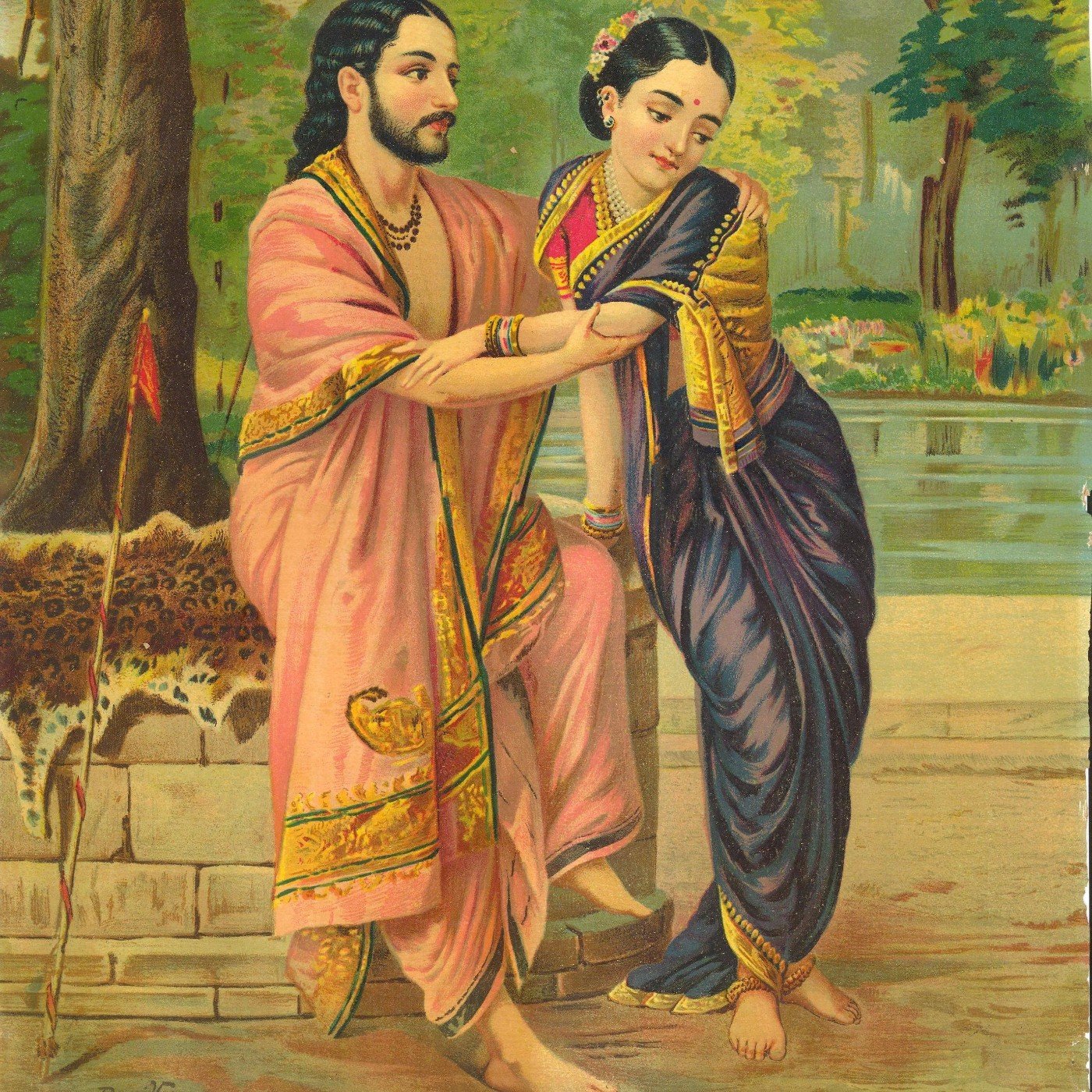 Arjuna Subhadra, oil painting by Raja Ravi Varma, (Image Credits: commons.wikimedia.org)
Arjuna Subhadra, oil painting by Raja Ravi Varma, (Image Credits: commons.wikimedia.org)
Title: Arjuna Subhadra
Creator: Raja Ravi Varma
Date Created: 1890
Physical Dimensions: 13.77 inches x 19.68 inches (35 cm x 50 cm)
Medium: Oil painting on canvas
Order Your Custom Handmade Oil Portrait Painting from Photo today
The clothing's bright blues and saffron create a sense of movement and energy, while the background's muted greens and browns suggest the natural beauty of the world around them. Arjuna and Subhadra are bathed in a warm, golden light that appears to glow from within them, lending them an almost divine quality.
Raja Ravi Varma expertly balances the figures of Arjuna and Subhadra, using their placement on the canvas to create a sense of dynamic tension. His meticulous attention to detail can be seen in the intricate patterns and designs of the saree, and the richness of the fabric and jewelry, which add a sense of understated elegance and opulence to the scene.
Arjuna Subhadra is another powerful example of Raja Ravi Varma's skill in capturing the romance and drama of the moment.
7. Lady with Fruit by Raja Ravi Varma
One of the most iconic paintings of Raja Ravi Varma is the Lady with fruit also known as Woman holding a fruit. The individual oil portrait painting on canvas showcases Varma's signature allure and subtlety but stands apart from his typical mystical narrative of mythological scenes. The romantic painting stands on its own merit, without any historical mythological context. The talent, dexterity, and subtlety of Raja Ravi Varma's skills and imagination are on full display in this masterpiece.
The lady in this oil painting is holding a single fruit in her right hand. In some cultures, such depictions are regarded as a symbol of fertility or sexual consciousness. Instead of being a subject in any of the mythological narrative scenes where the viewer is aware of the context and story, she becomes an enigmatic subject. Her eye contact, side gaze, and small coy smile, as well as her playful and inviting expression, draw viewers into her romantic gaze. Her presence is both alluring and subtle.
Was she caught off guard while enjoying the fruit, or is her coy smile an invitation? We may never know the answer, but the anonymity of the subject forces us to dive into her gaze and engage with the painting.
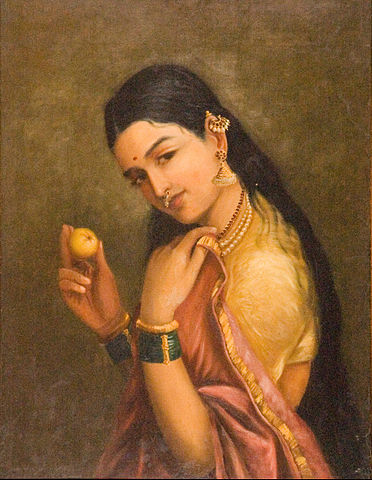 Woman holding fruit, oil painting by Raja Ravi Varma, (Image Credits: commons.wikimedia.org)
Woman holding fruit, oil painting by Raja Ravi Varma, (Image Credits: commons.wikimedia.org)
Title: Woman holding a fruit
Creator: Raja Ravi Varma
Date Created: Late 19th century
Physical Dimensions: 177.16 inches x 236.22 inches (450 cm x 600 cm)
Medium: Oil painting on canvas
Location: National Gallery of Modern Art, New Delhi, India
Varma's treatment of light highlights her movements, and the use of a dark flat background further emphasizes her three-dimensional presence. His palette captures the innocence and tenderness in her almond-shaped eyes, and her simpering look adds to her sensuality and romance. His brushstrokes are short but powerful, capturing each subtle emotion with clarity and precision. Her smooth curves and the meticulous detailing of her eyes give her an air of coquettishness and bashful reticence.
Her attire is painted in soft pink with a gold border, and brown and ochre tones are enhanced by the light falling on her left shoulder. Her figure is further enhanced with traditional Indian jewelry, including a necklace of double-folded pearls and a string of rubies.
While her real identity may remain a mystery forever, in the painting we can engage with her portrait in a way that is magical. The painting represents how Raja Ravi Varma was way ahead of his time.
6. Urvashi and Pururavas by Raja Ravi Varma
In the story from Indian mythology, King Pururavas falls in love with the celestial apsara Urvashi when she is sent down from the heavens. Despite being from two different worlds, they decide to get married. Pururavas, however, is bound by two conditions for marriage: he must never neglect her goats, and he must never present himself nude in front of her. Urvashi tells him that if he disobeys these conditions at any time, she would go back to heaven.
Pururavas remains true to his love and stays devoted to Urvashi, causing dismay to the Devas who want Urvashi back in their abode. In order to separate the two lovers, some of them come down stealthily at night and steal the goats. Hearing the animals' cries, Urvashi chides Pururavas for letting them go unattended. Rushing out to rescue them, the King is caught unawares as a flash of lightning reveals his naked self. Unfortunately, with the second condition also broken, albeit unwittingly, Urvashi is forced to fly back to the heavens even as a dispirited Pururavas desperately tries to stop her departure.
The painting of Raja Ravi Varma captures the moment when Urvashi flies back to heaven and Pururavas is heartbroken and desperate to stop her.
Urvashi and Pururavas is another magnificent example of Ravi Varma's mastery of form, composition, and color. Painted in oil painting on canvas, this work of art depicts the moment from Hindu mythology in which the celestial nymph Urvashi is flying back to heaven after the two conditions set by her were broken by Pururavas. And heartbroken Pururavas desperately tries to persuade her not to leave.
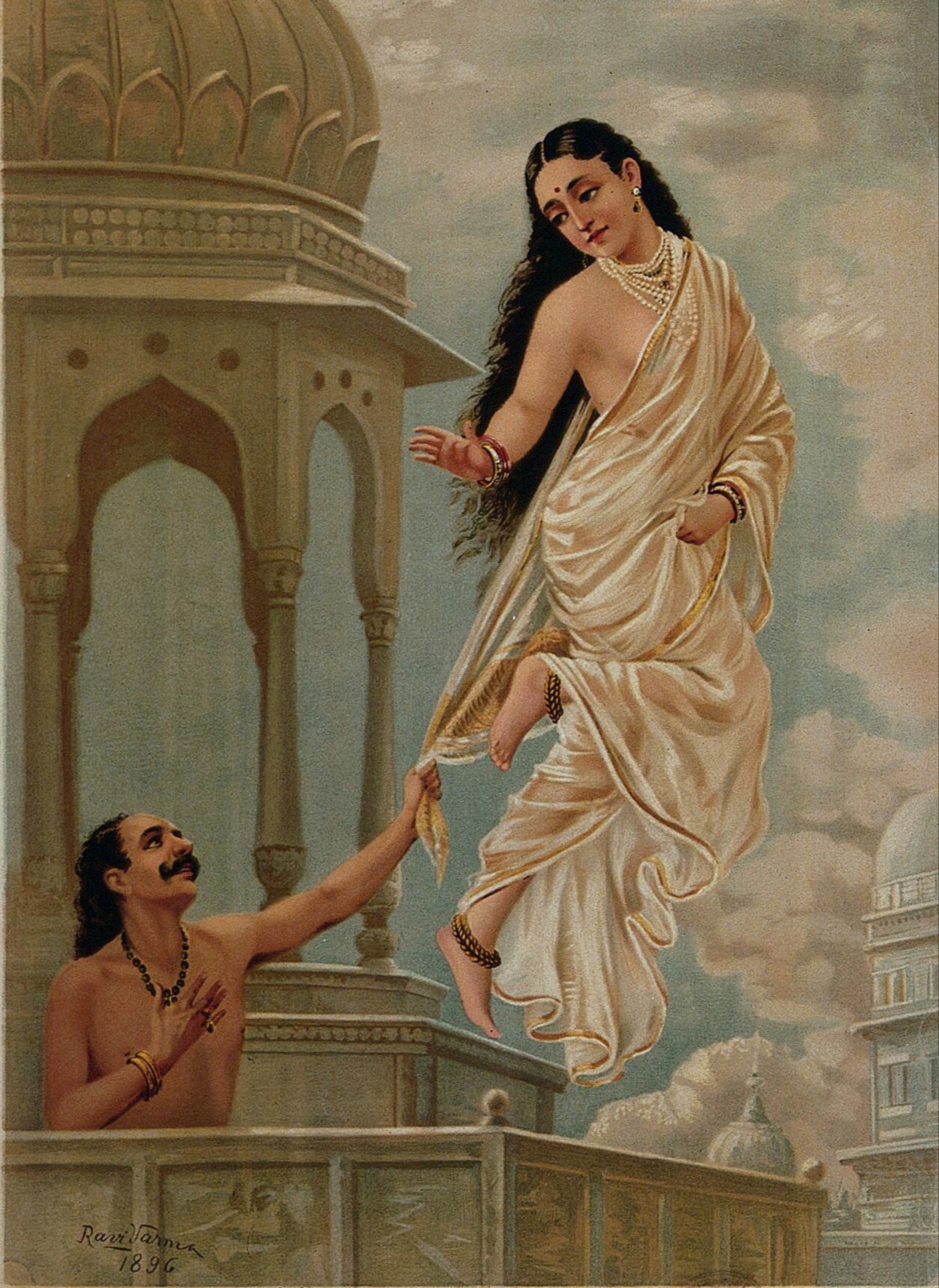 Urvashi Prurravas, canvas oil painting by Raja Ravi Varma
Urvashi Prurravas, canvas oil painting by Raja Ravi Varma
(Image Credits: commons.wikimedia.org)
Title: Urvashi and Pururavas
Creator: Raja Ravi Varma
Date Created: 1890
Medium: Oil painting on canvas
The canvas oil painting is notable for its light color scheme, which creates a sense of depth and luminosity. Raja Ravi Varma's use of color is particularly effective in capturing the ethereal beauty of Urvashi, whose pale skin seems to glow. And her face, radiant.
The composition of the painting is a testament to Raja Ravi Varma's skill. He expertly balances the figures of Urvashi and Pururavas, using their placement on the canvas to create a sense of movement and energy. Urvashi's flowing hair and saree suggest a sense of movement, while Pururavas' outstretched arm conveys a sense of desperation, longing, and desire. But where the painting truly excels is in depicting the emotions through their facial expressions. As Urvashi feels compelled to leave him for breaking her conditions, the viewer clearly feels the pain of the distraught Pururavas and the helplessness of Urvashi.
A notable aspect of the painting is the attention to detail in the clothing and accessories worn by the figures. Raja Ravi Varma's meticulous attention to detail can be seen in the realistic flow and folds of her saree and her delicate jewelry.
Urvashi and Pururavas' painting is another stunning example of Raja Ravi Varma's artistry and skill. It is a testament to his ability to capture the spirit and emotion of a moment, and to his mastery of color, form, and composition.
5. Stolen Interview by Raja Ravi Varma
The canvas oil painting depicts an admiring man gazing adoringly at the beautiful maiden in a scene of courtship, with her holding a pretty red rose in her hand. Her admirer may have gifted her the flower as a token of appreciation or as a gift. It makes her blush softly.
The young man's eyes shine with admiration as he gazes upon the beautiful maiden. She stands before him, a vision of loveliness, plucking the petals of a rose in her hand. The falling delicate petals of the rose, deep red and fragrant, seemed to reflect the underlying passion and give a sense of movement in the painting. There is something romantic in the air as the two stand together in this moment of courtship. A sweet reminder of the love and admiration that is been shared between them.
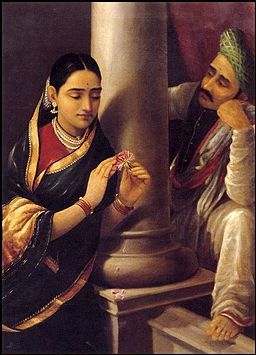 Stolen Interview, oil painting by Raja Ravi Varma, (Image Credits: commons.wikimedia.org)
Stolen Interview, oil painting by Raja Ravi Varma, (Image Credits: commons.wikimedia.org)
Title: Stolen Interview
Creator: Raja Ravi Varma
Date Created: 1880
Physical Dimensions: 24 inches x 29.6 inches (60.96 cm x 75.18 cm)
Medium: Oil painting on canvas
Location: Salar Jung Museum, Hyderabad, India
Raja Ravi Varma's use of light and shadow creates a sense of depth and dimensionality, making the couple seem almost three-dimensional. Muted colors contrast wonderfully with dark shades to create a memorable composition. The woman's shy expression, and lowered eyes, perfectly capture the sense of romance that the painting conveys.
4. Shakuntala Patra Lekhan by Raja Ravi Varma
Shakuntala Patra-lekhan is one of the earliest romantic historical narrative works of Raja Ravi Varma. One that got him recognition and acclaim and helped to establish him as the foremost historical narrative painter and artist of the period in India.
According to art historian, Tapti Guha-Thakurta, "Shakuntala Patra Lekhan’ (Shankuntala writing a love letter to Dushyanta), the first of his classical paintings became the path-breaking exhibit for the Madras display of 1876.” As per Partha Mitter, the painting was “enthusiastically” acquired by the Duke of Buckingham immediately at the Madras exhibition in 1876. Later, it was selected by the British scholar, Sir Monier Williams for reproduction in the frontispiece of his English translation of Kalidasa's Shakuntala. In the years that followed, the success of this painting opened the floodgates to a large number of similar historical narrative mythological paintings by Raja Ravi Varma.
Thakurta writes "These compositions grew out of the imagery he had already evolved through his portraits and life studies, particularly his studies of women in certain romantic and rarified moods and gestures. The same attention was paid to the splendor of costumes, ornaments, and the surrounding architectural decor, using the tactile and illusionist potential of oil paint to evoke the rustle of silk, the sheen of velvet, or the glitter of jewels."
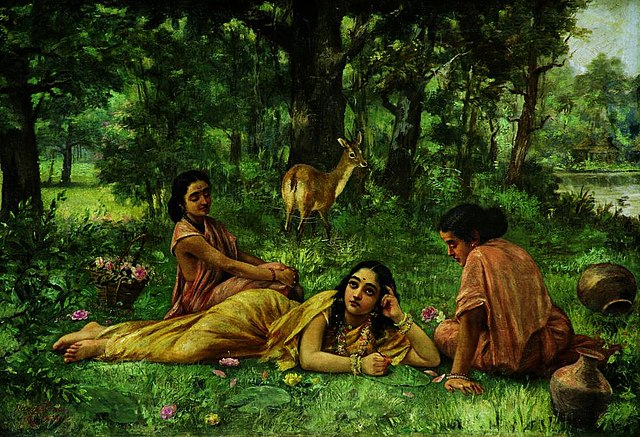 Shakuntala Patra Lekhan, oil painting by Raja Ravi Varma(Image Credits: commons.wikimedia.org)
Shakuntala Patra Lekhan, oil painting by Raja Ravi Varma(Image Credits: commons.wikimedia.org)
Title: Shakuntala Patra lekhan
Creator: Raja Ravi Varma
Date Created: 1876
Medium: Oil painting on canvas
The canvas oil painting depicts a scene from the Indian epic Mahabharata, in which Shakuntala is lying full length on the forest ground, writing a love letter on lotus leaves to her lover, Dushyanta. Raja Ravi Varma captures the emotion of the moment perfectly, with Shakuntala shown as lost in thought, completely absorbed in her writing. While her companions (sakhis), Anusuya, and Priyamvada look on. A flower basket lies near her feet. And water pitchers lie near her companions. In the background a deer is grazing. Flowers are strewn across the forest floor as if fallen off the flower basket. Imparting a sense of movement and dynamism to the painting. On the far right, one can see a partial water pond.
One of the most striking aspects of this painting is Raja Ravi Varma's use of color. He employs a rich, vibrant palette of greens, purples, and shades of black to recreate the forest feel. Giving the forest scene a sense of depth and texture.
Raja Ravi Varma pays immaculate attention to the various elements of the scene. From the folds in Shakuntala's sari to her floral ornaments. For example, while Shakunatala is shown wearing a flower garland, her companions are shown wearing rudraksha garlands. possibly indicating they are young sadhvis. The result is a painting that feels realistic and dreamlike, capturing the moment's essence while imbuing it with a sense of beauty and romance.
Overall, Shakuntala Patra Lekhan is a stunning example of Raja Ravi Varma's artistry and skill. It is a testament to his ability to capture the spirit and emotion of the moment, and to his mastery of color, form, and composition.
However, the painting was not universally acclaimed and appreciated. Sister Nivedita found the Shakuntala painting “ill-bred”. And criticized Varma, saying, “every home contains a picture of a fat young woman lying full length on the floor writing a letter on a lotus leaf"
3. Radha in Moonlight by Raja Ravi Varma
Possibly one of Ravi Varma’s exquisite masterpieces, "Radha in the Moonlight" is a stunning example of Raja Ravi Varma's unique style. The blending of traditional Indian painting techniques with the techniques of European academic painting. It was completed in 1890.
 Radha In Moonlight, oil painting by Raja Ravi Varma (Image Credits: commons.wikimedia.org)
Radha In Moonlight, oil painting by Raja Ravi Varma (Image Credits: commons.wikimedia.org)
Title: Radha in the Moonlight
Creator: Raja Ravi Varma
Date Created: 1890
Physical Dimensions: 57.5 inches x 41.5 inches (146 cm x 105.4 cm)
Medium: Oil painting on canvas
Location: Private Collection.
Unlike other Radha Krishna paintings, the oil painting on canvas depicts Radha, often associated with Krishna’s romantic interest, as she sits on the rocks as the shimmering moonlit river flows in the background, waiting for Krishna. Radha is shown wearing a traditional magenta Indian saree and jewelry, and she is depicted with great beauty and sensuality. Radha radiates the soft beauty, intelligence, and sensitivity of the “uttama nayika”. It can be seen easily that Radha, being a woman of unparalleled beauty, has been painted by Raja Ravi Varma with a particular focus, utmost care, and refinement. Aware of Krishna’s Godly qualities Radha has the pooja thali, the platter of flowers and sweetmeats near her, the ritual of worship and adulation to be completed before the love play (rasa lila) starts.
The painting's composition is typical of Ravi Varma's style, with Radha occupying most of the canvas. One can appreciate the efforts put in by Ravi Varma in the detailed work of Radha's jewelry and the background. The use of light and shadow to bring out the moonlit night effect is particularly noteworthy in this painting, with the moonlight casting a soft glow over Radha's face, her clothing, and her jewelry creating a sense of mystery and romance.
2. Damayanti and the Hamsa by Raja Ravi Varma
Damayanti and the Hamsa is another famous Oil painting on canvas by Raja Ravi Varma done in 1899. In the Sanskrit epic, Nala and Damayanti, Damayanti is the protagonist and heroine.
Using a golden swan as a messenger, they exchange messages. After the swans carry messages of love back and forth from one to the other, Nala and Damayanti fall in love with one another.
The story fascinated Ravi Varma so much that he painted multiple versions of Damayanti, including different poses and compositions. In this famous canvas oil painting, Damyanti is seen conversing with the swan. Ravi Varma aspired to give his Damayanti the same poetic beauty as the literary sources had described. This painting elevates Indian mythology's romantic epic from just a decorative painting into a meaningful portrayal through the harmonious interplay of its elements. Even in modern times, this scene and subject matter are considered among Raja Ravi Varma's most iconic romantic compositions.
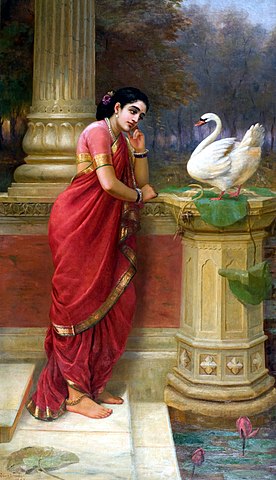 Damyanti and Hamsa oil painting by Raja Ravi Varma, (Image Credits: commons.wikimedia.org)
Damyanti and Hamsa oil painting by Raja Ravi Varma, (Image Credits: commons.wikimedia.org)
Title: Damayanti and the Hamsa
Creator: Raja Ravi Varma
Date Created: 1899
Physical Dimensions: 59.05 inches x 32.67 inches (150 cm x 83 cm)
Medium: Oil painting on canvas
Location: Sree Chitra Art Gallery, Thiruvananthapuram, India
Art historian Tapti Guha-Thakurta writes, “The woman is a perfect depiction of a gorgeously attired Indian lady in saree. The stately marble columns and marble steps suggest a palatial setting in keeping with her royal presence and status. At the same time, her tilted stance and her pensive expression transform her into an idealized symbol of womanhood. Finally, the image of the swan transports her beyond her immediate regional and social environs and beyond the generalized romantic mood into the mythic character of Damayanti, and makes her a part of an epic legend.”
1. Shakuntala by Raja Ravi Varma
Shakuntala also known as Shakutala removing a thorn from a foot or Shakutala looks back at Dushyanta. The oil painting on canvas is one of the most romantic paintings of Raja Ravi Varma.
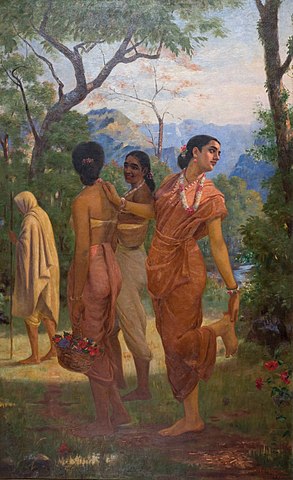 Shakuntala, oil painting Raja Ravi Varma,
Shakuntala, oil painting Raja Ravi Varma,
(Image Credits: commons.wikimedia.org)
Title: Shakuntala
Creator: Raja Ravi Varma
Date Created: 1898
Physical Dimensions: 43 inches x 71 inches (110 cm x 181 cm)
Medium: Oil painting on canvas
Location: Sree Chitra Art Gallery, Thiruvananthapuram, India
In the scene, Shakutala pretends to remove a thorn from her foot while searching for her lover, Dushyantha, while her friends tease her. Shakuntala's mannered pose and captivating expression identify her as a romantic heroine among the other figures. Her simple saffron garments and floral ornaments mark her as the forest maiden of the Kalidasa epic; a standard landscape of trees and mountains becomes the hermitage of Kanva-muni; By constructing in his imagination the events and images that might have preceded and those that might have followed, the viewer makes this composition a part of a narrative overall.
Expressing admiration for the romantic and sensual nature of the painting, art historian Tapati Guha-Thakurta, writes, "This very gesture – the twist and turn of head and body – draws the viewer into the narrative, inviting one to place this scene within an imagined sequence of images and events. On its own, the painting stands like a frozen tableau (like a still from a moving film), plucked out of an on-running spectacle of episodes. These paintings also reflect the centrality of the "male gaze" in defining the feminine image. Though absent from the pictorial frame, the male lover forms a pivotal point of reference, his gaze transfixes Shakuntala, as also Damayanti, into "desired" images, casting them as lyrical and sensual ideals."
Conclusion
Raja Ravi Varma, known as the “painter among Princes and Prince among painters” will be remembered forever for his romantic historical narrative paintings, portraits, and paintings of Hindu Gods.
Rabindranath Tagore, Nobel laureate, poet, painter, philosopher, and artist said of Ravi Varma, in Chinna Patrabali (12 May 1893), “Today the entire moringing went looking at the paintings of Ravi Varma. I liked them very much. The secret of their appeal is in reminding us how precious our own culture is to us in restoring our inheritance. In some of the paintings, the proportions were off a bit, but overall they capture your heart. Our heart here acts as an ally of the artist. Our hearts can almost anticipate what he is about to say. It is all too easy to find fault with him. But we must remember that it is a lot easier to imagine a subject than to paint it. A vision has the freedom to be imprecise. But if that mental vision has to be turned into something concrete as a painting, where even a single line cannot be drawn out of place, then that task is no easy matter."
There you have it. The 10 famous romantic paintings by Raja Ravi Varma.
About Us:
Paintphotographs.com is India's leading custom art platform. We turn your favorite photos, pics, and images into luxurious handmade portrait paintings. Our work includes handmade portraits, custom oil reproductions, charcoal drawings, and sketches. As a team of accomplished artists, we use museum-quality canvas, the best international brands of colors such as Winsor & Newton and Daler Rawney. We work with various mediums, including oil, acrylic, mixed media, graphite, and charcoal.
To order a custom handmade oil portrait painting you can visit our order now page. You can order custom Wedding Paintings, Couple Paintings, Memorial Paintings, Family Paintings, Baby portraits and Children Paintings, Photo to paintings, and Pet Portrait Paintings from Photo.
You can visit our pricing page to know the prices of our portrait paintings. To connect with us ping us on our chat messenger on the website, ping us on WhatsApp, call us at 918291070650, or drop us an email at support@paintphotographs.com
You can visit our gallery pages to see our work. We make photo to paintings, couple paintings, memorial paintings, Kids and Baby Portrait paintings, God & Religious Paintings, Old Photo to Paintings, Wedding couple Paintings & Marriage Portraits, Family Paintings, Pet Portrait Paintings, Radha Krishna Paintings, Oil Portraits of Gurus, Saints & Holy Men, Charcoal and Pencil Sketches, Custom Landscape & Cityscape paintings, Contemporary Art Reproduction & Replica Paintings, Old Master Reproduction & Replica Art, Monochrome and Black & White portrait paintings, Historical Portraits and Shivaji Maharaj Paintings, Celebrity & Political Leaders Portraits. We can also merge separate photos to create a single seamless painting called Composite portraits to add deceased loved ones to make a family oil portrait as though they were present.
Our custom handmade portraits make beautiful Anniversary Gifts, Engagement Gifts, Birthday Gifts, Retirement Gifts, Housewarming Gifts, Mother's Day gifts, and luxurious gifts for many important occasions.
Paintphotographs.com provides bespoke services for art patrons, interior designers, and architects. It helps you create the perfect pieces for residential and commercial projects and serves as a platform for artists to showcase their work.
If you are an art aficionado interested in writing a guest post on art, connect with us.
Want to read more? Check our reading recommendations below! Please refer to the Notes and Reference section for sources referenced in the article.
Like this story? Then you will love our podcasts on Spotify. Listen to our deep dives and fascinating stories from the art world. Join our nearly 20,000-strong community on Facebook, WhatsApp, and X.
Want to see our art? Join our community of 500,000+ subscribers on the Paintphotographs YouTube channel, Instagram, and Pinterest for some amazing art pics & art videos!
Recommended Pieces
Uncover the mystical beauty of Shri Krishna paintings and art through the ages | Paintphotographs
A brief history of oil painting technique | Paintphotographs
Ultimate 20 Best Oil Portrait Paintings of John Singer Sargent (Ranked) | Paintphotographs
Photorealism: The Art of making a painting from a photo. | Paintphotographs
The life and paintings of artist and painter KCS Paniker | Paintphotographs
Why is the Monalisa so famous? Monalisa's portrait painting history | Paintphotographs
Memorial Paintings - The Ultimate Guide to Commissioning one | Paintphotographs
Notes and reference section
Thematic Study of the Indian Colonial Painter Raja Ravi Varma
(DOC) THE REAL GOD OF ART: RAJA RAVI VARMA 'The Forgotten Hero' | Dr.Yogesh Sharma - Academia.edu
Mitter, Partha. Artist as charismatic individual: Raja Ravi Varma
Women and Art in Colonial India
The dark shades of Raja Ravi Varma | Mint Lounge
Creating An Indian Beauty, Ravi Varma Style — Google Arts & Culture
Shakuntala's Impending Calamity - Raja Ravi Varma — Google Arts & Culture
Raja Ravi Varma Heritage Foundation
https://www.google.co.in/books/edition/The_Painter/BRZ-013-2bQC?hl=en&gbpv=1
Shakuntala's Impending Calamity - Raja Ravi Varma — Google Arts & Culture

